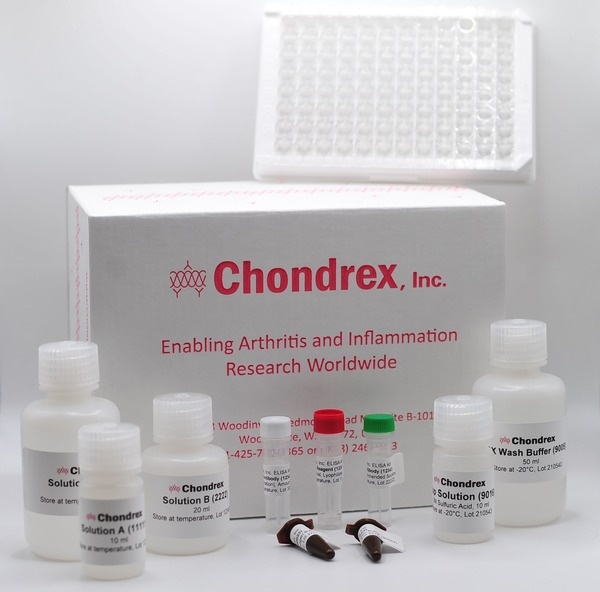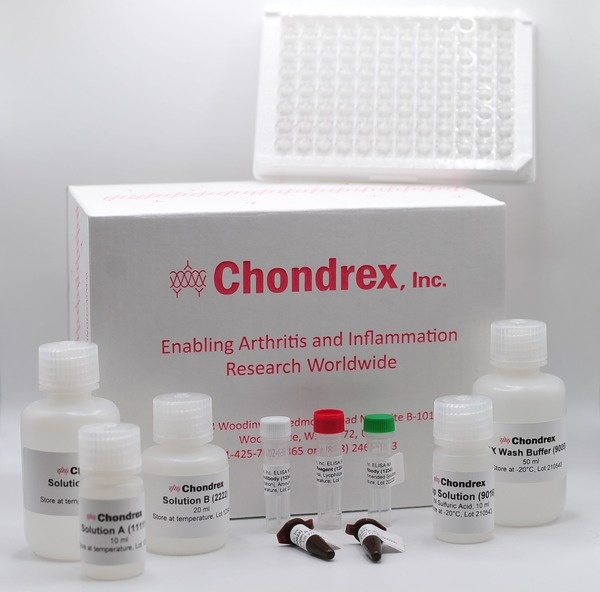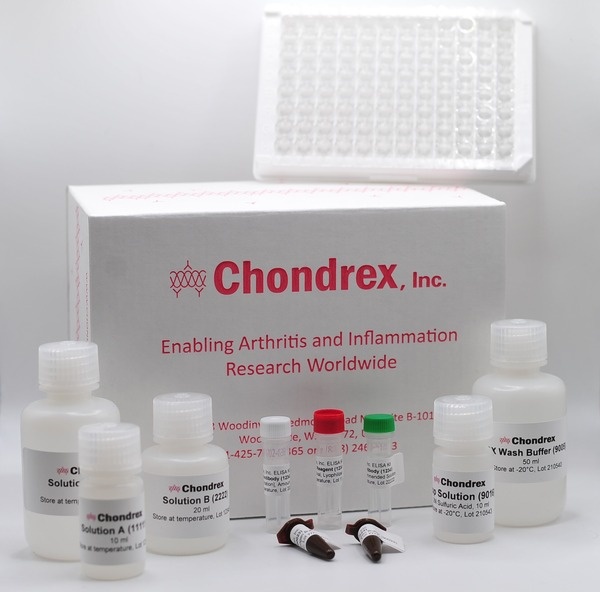Proteases are enzymes that hydrolyze proteins into smaller peptides or individual amino acids. Proteases play essential roles in biological processes, such as digestion, blood clotting, immune responses, and cell signaling. They work highly specific to amino acid sequences within a protein. This specificity allows for precise control over protein function and degradation (1, 2).
Chondrex, Inc., offers proteinase activity assay kits and enzymes for assaying the physiological activities of proteins involved in biological functions as well as protein manipulation and purification.
Proteinase Activity Assay Kits
| Product | Catalog # | Price (USD) | |
|---|---|---|---|
 |
Bacterial Collagenase Assay Kit | 3014 | 433.00 |
 |
Cysteine Protease Activity Assay Kit | 3101 | 355.00 |
 |
Rapid Collagenase Assay Kit with Type I Collagen Substrate | 3001 | 535.00 |
 |
Rapid Collagenase Assay Kit with Type II Collagen Substrate | 3002 | 535.00 |
 |
Trypsin Activity Assay Kit | 3043 | 355.00 |
Proteinases
| Product | Catalog # | Price (USD) | |
|---|---|---|---|
 |
Elastase from Porcine Pancreas, 1 mg | 30047 | 47.00 |
 |
Elastase from Porcine Pancreas, 10 mg | 300471 | 423.00 |
 |
Papain | 60224 | 22.00 |
 |
Pepsin | 6011 | 14.00 |
 |
Recombinant Human MMP-8 (Full length, Latent Form) (BACK-ORDERED UNTIL FURTHER NOTICE) | 5001 | 310.00 |
 |
Trypsin | 30045 | 47.00 |
Proteinases
Proteinases are divided into 4 classes based upon specific residues found in their active sites. These classes of proteinases are aspartic proteinases, cysteine proteinases, metalloproteinases, and serine proteinases. The following are key examples, highlighting their specific functions and importance.
Collagenase: A family of metalloproteases that specifically target collagen in the body's connective tissues. Dysregulation of collagenase activity can contribute to various pathological conditions, such as arthritis and cancer metastasis (3)
Elastase: A serine protease released by neutrophils (a type of white blood cell), which plays a role in immune responses by degrading bacterial proteins and contributing to the formation of neutrophil extracellular traps (NETs)(4–6).
Papain: A cysteine protease involved in a wide range of cellular processes including protein degradation, antigen processing, and apoptosis (programmed cell death)(7).
Pepsin: An aspartic protease which preferentially cleaves peptide bonds where the amino acids phenylalanine, tyrosine, or tryptophan are present. Pepsin's primary function is to begin the digestion of proteins in the stomach. The products of pepsin digestion are larger peptides, which are further broken down by other proteases in the small intestine (8).
Trypsin: A serine protease which cleaves peptide bonds at specific sites, primarily where the amino acids lysine or arginine are present. It is secreted in its inactive form, trypsinogen, and is activated by enterokinase. It also activates other digestive enzymes, contributing to the overall process of nutrient absorption(5, 6).
Proteinase Inhibitors
Proteinase inhibitors control the activity of proteinases. Proteinases are grouped into four classes based on specific amino acids in their active sites. These classes are aspartic proteinases, cysteine proteinases, metalloproteinases, and serine proteinases. Proteinase inhibitors are generally divided into two categories: nonspecific inhibitors and class-specific inhibitors (2).
When measuring proteinase activity, selecting the right substrate is essential. Using the correct inhibitors in these assays is also crucial for accurate data, especially when samples contain multiple types of proteinases.
Proteinase inhibitors
| Protease Types | Inhibitors | Reference |
Aspartic Protease (Pepsin) | Pepstatin A | (9) |
| α2-Macroglobulin | (10) | |
Cysteine Protease (Papain) | Cystatin | (11) |
| NEM (N-Ethylmaleimide) | (12) | |
Metalloprotease (Collagenase) | EDTA | (13) |
| TIMPs (Tissue Inhibitors of Metalloproteinases) | (14) | |
Serine Protease (Elastase/Trypsin) | Aprotinin | (15) |
| Leupeptin | (16) | |
| PMSF (Phenylmethylsulfonyl fluoride) | (17) | |
| α2-Macroglobulin | (10) | |
| Soybean Trypsin Inhibitor | (18) | |
| TLCK (Nα-Tosyl-L-lysine chloromethyl ketone) | (19) | |
| TPCK (N-Tosyl-L-phenylalanine chloromethyl ketone) | (19) |
References
- C. López-Otín, J. S. Bond, Proteases: multifunctional enzymes in life and disease. J. Biol. Chem. 283, 30433–30437 (2008).
- K. Hibbetts, B. Hines, D. Williams, An overview of proteinase inhibitors. J. Vet. Intern. Med. 13, 302–308 (1999).
- J. F. Woessner Jr, Matrix metalloproteinases and their inhibitors in connective tissue remodeling. FASEB J. 5, 2145–2154 (1991).
- P. M. Fitch, A. Roghanian, S. E. M. Howie, J.-M. Sallenave, Human neutrophil elastase inhibitors in innate and adaptive immunity. Biochem. Soc. Trans. 34, 279–282 (2006).
- D. C. Whitcomb, M. E. Lowe, Human pancreatic digestive enzymes. Dig. Dis. Sci. 52, 1–17 (2007).
- E. Di Cera, Serine proteases. IUBMB Life 61, 510–515 (2009).
- F. Mamboya, E. Amri, Papain, a plant enzyme of biological importance: A review. Am. J. Biochem. Biotechnol. 8, 99–104 (2012).
- B. M. Dunn, Structure and mechanism of the pepsin-like family of aspartic peptidases. ChemInform 34 (2003).
- J. Marciniszyn Jr, J. A. Hartsuck, J. Tang, Mode of inhibition of acid proteases by pepstatin. J. Biol. Chem. 251, 7088–7094 (1976).
- A. J. Barrett, “[54] α2-Macroglobulin” in Methods in Enzymology (Elsevier, 1981)Methods in enzymology, pp. 737–754.
- M. Abrahamson, R. W. Mason, H. Hansson, D. J. Buttle, A. Grubb, K. Ohlsson, Human cystatin C. role of the N-terminal segment in the inhibition of human cysteine proteinases and in its inactivation by leucocyte elastase. Biochem. J. 273 ( Pt 3), 621–626 (1991).
- D. P. Thorne, T. D. Lockwood, Four proteolytic processes of myocardium, one insensitive to thiol reactive agents and thiol protease inhibitor. Am. J. Physiol. 265, E10-9 (1993).
- J. M. Thompson, K. Agee, S. J. Sidow, K. McNally, K. Lindsey, J. Borke, M. Elsalanty, F. R. Tay, D. H. Pashley, Inhibition of endogenous dentin matrix metalloproteinases by ethylenediaminetetraacetic acid. J. Endod. 38, 62–65 (2012).
- A. H. Baker, D. R. Edwards, G. Murphy, Metalloproteinase inhibitors: biological actions and therapeutic opportunities. J. Cell Sci. 115, 3719–3727 (2002).
- S. Westaby, Aprotinin in perspective. Ann. Thorac. Surg. 55, 1033–1041 (1993).
- T. Saino, T. Someno, S. Ishii, T. Aoyagi, H. Umezawa, Protease-inhibitory activities of leupeptin analogues. J. Antibiot. (Tokyo) 41, 220–225 (1988).
- V. Sekar, J. H. Hageman, Specificity of the serine protease inhibitor, phenylmethylsulfonyl fluoride. Biochem. Biophys. Res. Commun. 89, 474–478 (1979).
- B. H. Vagadia, S. K. Vanga, V. Raghavan, Inactivation methods of soybean trypsin inhibitor – A review. Trends Food Sci. Technol. 64, 115–125 (2017).
- I. Frydrych, P. Mlejnek, Serine protease inhibitors N-alpha-tosyl-L-lysinyl-chloromethylketone (TLCK) and N-tosyl-L-phenylalaninyl-chloromethylketone (TPCK) are potent inhibitors of activated caspase proteases. J. Cell. Biochem. 103, 1646–1656 (2008).